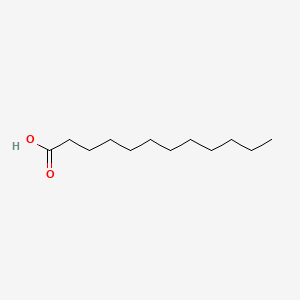lauric acid
lauric acid is a lipid of Fatty Acyls (FA) class. Lauric acid is associated with abnormalities such as Infection, Renal tubular disorder, Hypertensive disease, Obesity and Mycoses. The involved functions are known as Transcription, Genetic, Signal Transduction, Mutation, metaplastic cell transformation and Anabolism. Lauric acid often locates in Skin, Plasma membrane, Cytoplasmic matrix, Body tissue and Palmar surface. The associated genes with lauric acid are Gene Family, SLC33A1 gene, Homologous Gene, Open Reading Frames and P4HTM gene. The related lipids are Fatty Acids, Oleic Acids, Palmitates, Stearates and 9,11-linoleic acid.
Cross Reference
Introduction
To understand associated biological information of lauric acid, we collected biological information of abnormalities, associated pathways, cellular/molecular locations, biological functions, related genes/proteins, lipids and common seen animal/experimental models with organized paragraphs from literatures.
What diseases are associated with lauric acid?
lauric acid is suspected in Renal tubular disorder, Hypertensive disease, Infection, Renal vascular disorder, Obesity, Mycoses and other diseases in descending order of the highest number of associated sentences.
Related references are mostly published in these journals:
| Disease | Cross reference | Weighted score | Related literature |
|---|
Possible diseases from mapped MeSH terms on references
We collected disease MeSH terms mapped to the references associated with lauric acid
PubChem Associated disorders and diseases
What pathways are associated with lauric acid
There are no associated biomedical information in the current reference collection.
PubChem Biomolecular Interactions and Pathways
Link to PubChem Biomolecular Interactions and PathwaysWhat cellular locations are associated with lauric acid?
Visualization in cellular structure
Associated locations are in red color. Not associated locations are in black.
Related references are published most in these journals:
| Location | Cross reference | Weighted score | Related literatures |
|---|
What functions are associated with lauric acid?
Related references are published most in these journals:
| Function | Cross reference | Weighted score | Related literatures |
|---|
What lipids are associated with lauric acid?
Related references are published most in these journals:
| Lipid concept | Cross reference | Weighted score | Related literatures |
|---|
What genes are associated with lauric acid?
Related references are published most in these journals:
| Gene | Cross reference | Weighted score | Related literatures |
|---|
What common seen animal models are associated with lauric acid?
There are no associated biomedical information in the current reference collection.
NCBI Entrez Crosslinks
All references with lauric acid
Download all related citations| Authors | Title | Published | Journal | PubMed Link |
|---|---|---|---|---|
| Sampey BP et al. | Metabolomic profiling reveals mitochondrial-derived lipid biomarkers that drive obesity-associated inflammation. | 2012 | PLoS ONE | pmid:22701716 |
| Khare G et al. | Dissecting the role of critical residues and substrate preference of a Fatty Acyl-CoA Synthetase (FadD13) of Mycobacterium tuberculosis. | 2009 | PLoS ONE | pmid:20027301 |
| Lo CC et al. | HIV delays IFN-α production from human plasmacytoid dendritic cells and is associated with SYK phosphorylation. | 2012 | PLoS ONE | pmid:22693567 |
| Nagelkerken I et al. | Effects of marine reserves versus nursery habitat availability on structure of reef fish communities. | 2012 | PLoS ONE | pmid:22675474 |
| Laroui H et al. | Dextran sodium sulfate (DSS) induces colitis in mice by forming nano-lipocomplexes with medium-chain-length fatty acids in the colon. | 2012 | PLoS ONE | pmid:22427817 |
| Shen C et al. | Evaluation of cervical mucosa in transmission bottleneck during acute HIV-1 infection using a cervical tissue-based organ culture. | 2012 | PLoS ONE | pmid:22412886 |
| David HN et al. | Ex vivo and in vivo neuroprotection induced by argon when given after an excitotoxic or ischemic insult. | 2012 | PLoS ONE | pmid:22383981 |
| Rodriguez Rodrigues C et al. | Epithelial cells activate plasmacytoid dendritic cells improving their anti-HIV activity. | 2011 | PLoS ONE | pmid:22163327 |
| Hirbod T et al. | In situ distribution of HIV-binding CCR5 and C-type lectin receptors in the human endocervical mucosa. | 2011 | PLoS ONE | pmid:21984929 |
| Zotev V et al. | Self-regulation of amygdala activation using real-time FMRI neurofeedback. | 2011 | PLoS ONE | pmid:21931738 |
| Carrington LB et al. | A re-examination of Wolbachia-induced cytoplasmic incompatibility in California Drosophila simulans. | 2011 | PLoS ONE | pmid:21799900 |
| Li J et al. | Biogeographical consequences of Cenozoic tectonic events within East Asian margins: a case study of Hynobius biogeography. | 2011 | PLoS ONE | pmid:21738684 |
| Schaefers MM et al. | Epithelial proinflammatory response and curcumin-mediated protection from staphylococcal toxic shock syndrome toxin-1. | 2012 | PLoS ONE | pmid:22431984 |
| Lau SC et al. | Enhanced biocatalytic esterification with lipase-immobilized chitosan/graphene oxide beads. | 2014 | PLoS ONE | pmid:25127038 |
| Mazloumian A et al. | How citation boosts promote scientific paradigm shifts and nobel prizes. | 2011 | PLoS ONE | pmid:21573229 |
| Nakatsuji T et al. | Propionibacterium acnes CAMP factor and host acid sphingomyelinase contribute to bacterial virulence: potential targets for inflammatory acne treatment. | 2011 | PLoS ONE | pmid:21533261 |
| Inácio ÂS et al. | In vitro surfactant structure-toxicity relationships: implications for surfactant use in sexually transmitted infection prophylaxis and contraception. | 2011 | PLoS ONE | pmid:21603626 |
| Wei J et al. | Plants attract parasitic wasps to defend themselves against insect pests by releasing hexenol. | 2007 | PLoS ONE | pmid:17786223 |
| Keller MJ et al. | A randomized trial to assess anti-HIV activity in female genital tract secretions and soluble mucosal immunity following application of 1% tenofovir gel. | 2011 | PLoS ONE | pmid:21283552 |
| Lee YJ et al. | Defects in very long chain fatty acid synthesis enhance alpha-synuclein toxicity in a yeast model of Parkinson's disease. | 2011 | PLoS ONE | pmid:21264320 |
